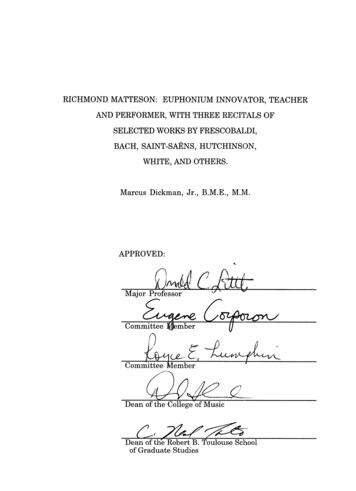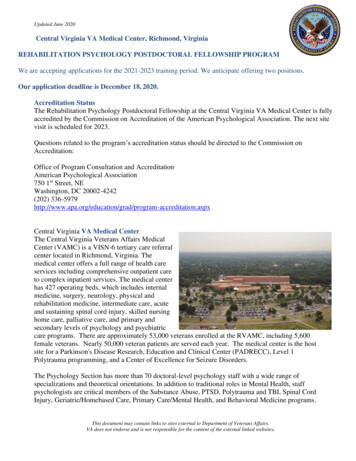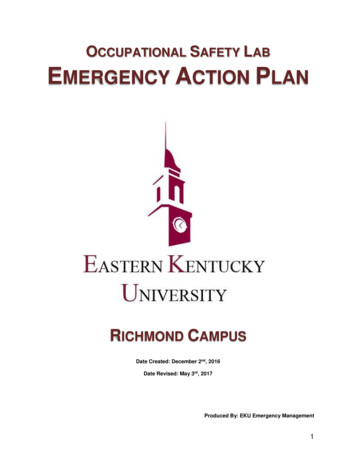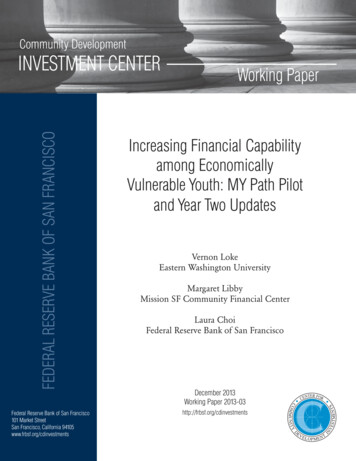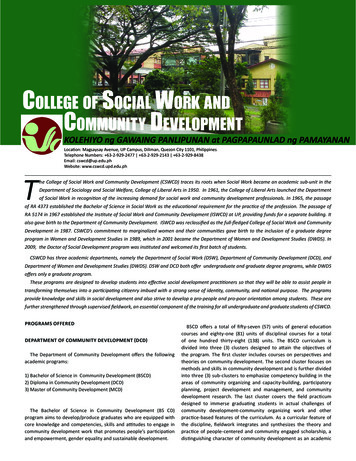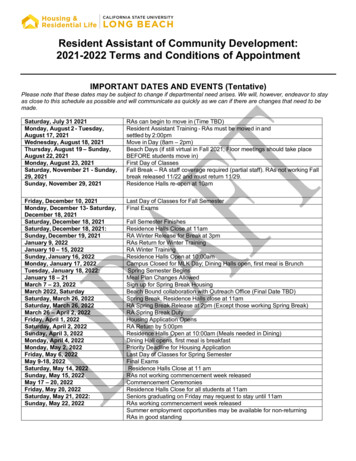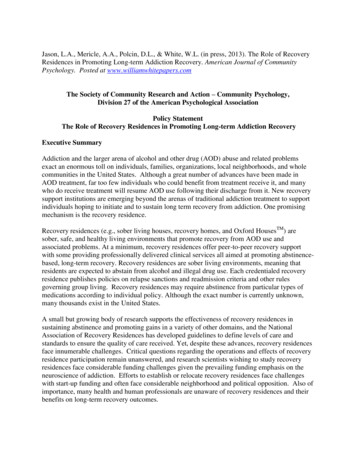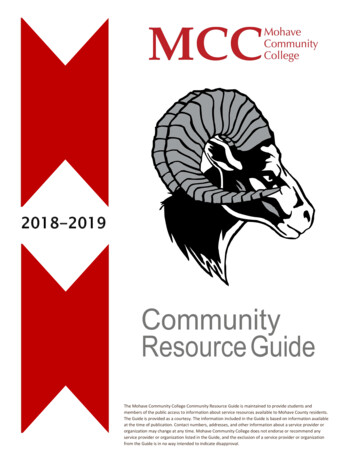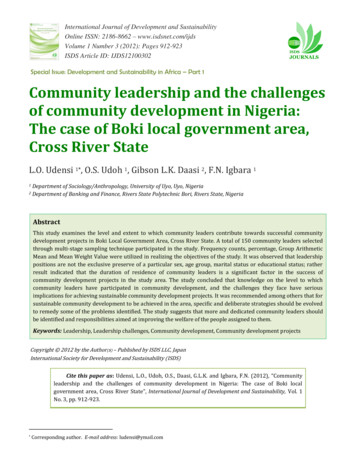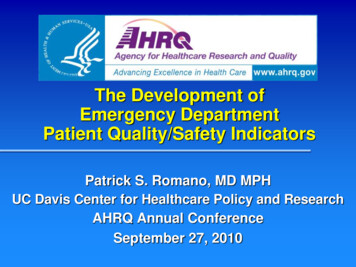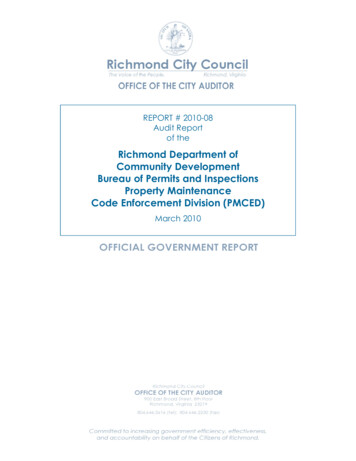
Transcription
REPORT # 2010-08Audit Reportof theRichmond Department ofCommunity DevelopmentBureau of Permits and InspectionsProperty MaintenanceCode Enforcement Division (PMCED)March 2010
TABLE OF CONTENTSExecutive Summary . . . iComprehensive List of Recommendations .ivIntroduction, Objective and Methodology . . . . . 1Background Information . . . . .3Observations and Recommendations . 10Management Responses Appendix I
City of RichmondCity AuditorExecutive SummaryMarch 1, 2010The Honorable Members of Richmond City CouncilThe Richmond City Audit CommitteeMr. Byron C. Marshall, CAOSubject: Community Development – Property Maintenance Code Enforcement AuditThe City Auditor’s Office has completed an operational audit of the Department of CommunityDevelopment’s Property Maintenance Code Enforcement Division (PMCED). This audit wasconducted in accordance with generally accepted government auditing standards promulgated bythe Comptroller General of the United States. The standards provide a reasonable basis for ourconclusions regarding the internal control structure of PMCED and the recommendationspresented.The mission of PMCED is to protect all citizens and visitors’ health and safety. The Divisionfollows the Virginia Uniform State Building Code (USBC) and City environmental ordinances asa basis for compliance and citations. The dynamics and the characteristics of neighborhoods arechanging; the housing stock is getting older and demands continued repair and maintenance.According to the 2006 – 2008 U.S. Census Bureau, 85% of the housing units in Richmond werebuilt before 1979; of those, approximately 56,500 (60%) of the units were built before 1960.Maintenance of older properties may be expensive. Non-maintenance could result indeterioration of the properties. The widely accepted broken window theory states that blightcaused by unabated code violations or other means could encourage criminal behavior. InRichmond, there appears to be a correlation between code violations and crime. Enforcement ofcode could deter certain types of crime.The following are the salient findings of the audit: PMCED has taken some steps to reduce blight through property rehabilitation. However,based on available data, auditors were unable to determine the total number of propertiesrehabilitated or the overall impact of these efforts on the resolution of code violations inRichmond. The above efforts are encouraging; however, more efforts are necessary toaddress citywide code enforcement issues.
Similar to unmaintained private properties observed during this audit, the auditors alsofound that certain City owned properties and City rights of way areas were not incompliance with City code. PMCED must communicate code violations on City ownedproperties to the appropriate agencies.A formal written, comprehensive procedures manual was not available within PMCED.Policies and procedures not only help ensure compliance with laws and regulations, butensure consistency of operations and clarify the expectations and responsibilities ofemployees in providing service delivery to customers.During the audit, 46% of the requested files could not be located. Some of the files maynot have been maintained because inspectors have been instructed to destroyenvironmental files once abated. There was no process in place to ensure that inspectionfiles are adequately maintained and safeguarded. In these circumstances, inadequateenforcement or lack of productivity may not be detected.Several files did not include adequate evidence to determine why the case was closed.Auditors noted examples of computer files not being updated. In addition, fieldobservations indicated that cases may not have been properly closed.Auditors found that the Supervisors did not monitor field employees’ work adequately.File reviews during the period from November 2008 through June 2009 indicated thatonly 10% of the required 78 field inspections and 60% of the random file checks wereconducted.Auditors found that 40% of selected vacant properties were not monitored in a timelymanner. It is important to monitor vacant and abandoned structures because they invitecrime, cause community blight and present potential hazards. The auditors observed thatconflicting guidance was provided to staff. The requirements for inspection of vacantproperties were changed from 90 days to 45 days and vice versa.The performance measures established by the Division do not provide a clear means toevaluate the effectiveness of the program. Overall, PMCED currently lacks appropriatemechanisms to monitor, measure and manage departmental and employee performance.The number of violation identified was inflated in communication to the CAO’s office.Adopting outcome measures recommended by Richmond Works would enable thedepartment and City Administration to gauge services provided by this Division.A notice of violation must be provided to the property owner before any legal action canbe taken. In cases of rental properties and absentee owners, PMCED inspectors mustresearch to determine who owns the property. Through discussions with PMCEDpersonnel and the City Attorney’s Office, the overwhelming consensus is that theefficiency of PMCED inspectors could be improved by dedicating one individual to dothe research required for locating property owners.900 East Broad Street, Room 806 * Richmond, VA 23219 * 804.646.5616 * Fax 804.646.2230 * www.richmondgov.comPage ii of iii
Based on focus groups input and research done by the City Auditor’s Office, it appearsthat conducting proactive inspections would benefit the City by reducing non-compliancewith the City codes. There is a technology already available to the City that could assistin selecting areas for proactive code enforcement for maximum effectiveness.The City Auditor’s Office appreciates the cooperation of the City staff during this audit. Awritten response to the report including an action plan and target dates for implementation hasbeen received and is an appendix to this report. Please contact the City Auditor’s Office if youhave any questions or comments.Sincerely,Umesh Dalal, CPA, CIA, CIGCity Auditor900 East Broad Street, Room 806 * Richmond, VA 23219 * 804.646.5616 * Fax 804.646.2230 * www.richmondgov.comPage iii of iii
COMMUNITY DEVELOPENT2010-08PROPERTY MAINTENANCE CODE ENFORCEMENT DIVISION (PMCED)#COMPREHENSIVE LIST OF RECOMMENDATIONSPAGE1 Establish a policy to communicate to the Department of Public Works (DPW) or theDepartment of Public Utilities (DPU) any violations not under the purview of PMCED toensure they are addressed.122 Update and distribute policy and standard operating procedures manuals.143 Provide on-going training related to compliance with the policies and procedures.144 Perform an annual review of policy and procedures, and revise as necessary.145 Monitor on-going compliance with policy and procedures.146 Establish file maintenance guidelines through written procedures that include which filesand file contents need to be maintained, file storage, file security, and access.177 Update the computerized database in a timely manner.178 Refine search to capture all the vacant properties.179 Reinforce and monitor performance of staff at all levels.2110 Enforce requirements for field performance evaluations and random file checks.2111 Require supervisory staff to monitor zones on a routine basis to judge the effectiveness ofthe inspector. Require a written report of findings.2112 Clarify with staff and document the guidelines for performing vacant property inspectionsin a formal policy.2113 Monitor vacant property inspections to ensure that established guidelines are being met.2114 Report only the actual number of code violations to the CAO.2415 Adopt measures of effectiveness to include the measures recommended by Richmond Works.2416 Maintain source documentation to support management reports provided to the CityAdministration.2417 Accumulate accurate workload data. Using this data, evaluate the adequacy of existingstaffing and justify the staffing changes desired.2618 Develop a pilot proactive code enforcement neighborhood volunteer program to supplementstaffing.2719 Recruit, train and supervise individuals for the role of volunteer property maintenanceinspectors.2720 To increase staff efficiency, dedicate at least one position for researching and locatingabsentee landlords and property owners.2821 Increase inspection effectiveness by enhancing current proactive inspection procedures.2922 Utilize available technology to enhance the ability to identify code violations, monitorinspection zones, and provide greater proactive enforcement.2923 Improve communication within the Planning and Development Review Department toensure use of proper information in making operational decisions.31Page iv
COMMUNITY DEVELOPENT2010-08PROPERTY MAINTENANCE CODE ENFORCEMENT DIVISION (PMCED)#RECOMMENDATIONPAGE24 Provide better feedback to the citizens concerning the resolution of code enforcementcomplaints.3325 Adopt policies and practices that encourage citizen support and neighborhood participation.3326 Solicit feedback from complainants and property owners on their code enforcementexperience, where possible.3327 Provide education forums for property owners on basic code enforcement and propertymaintenance requirements.3328 Implement a pilot rental inspection program. Expand this program if the results from thepilot program are positive.34Page v
City of Richmond Audit Report 2010-08Community Development – Bureau of Permits and InspectionsProperty Maintenance Code Enforcement DivisionFebruary 2010Page 1 of 34Introduction, Objectives and MethodologyIntroductionThe City Auditor’s Office has completed an operational audit of theDepartment of Community Development’s Property Maintenance CodeEnforcement Division (PMCED). This audit covers PMCED’s activitiesduring the 12-month period that ended December 31, 2008.This audit was conducted in accordance with generally acceptedgovernment auditing standards promulgated by the ComptrollerGeneral of the United States. The standards provide a reasonable basisfor our conclusions regarding the internal control structure of PMCEDand the recommendations presented.Audit ObjectiveOverall objectives of the audit were to: ions; and MethodologyVerify compliance with laws, regulations and policies.To complete this audit, the auditor performed the following procedures: Gathered and reviewed background information; Interviewed staff and management; Reviewed and evaluated policies and procedures; Reviewed performance indicators and standards utilized byother cities and counties; Reviewed financial and operational/performance information; Rode along with field inspectors; and Performed other audit procedures as deemed necessary.
City of Richmond Audit Report 2010-08Community Development – Bureau of Permits and InspectionsProperty Maintenance Code Enforcement DivisionFebruary 2010ManagementResponsibilityPage 2 of 34The management of the City of Richmond is responsible for ensuringresources are managed properly and used in compliance with laws andregulations, City programs are achieving their objectives, and servicesare being provided efficiently, economically and effectively.
City of Richmond Audit Report 2010-08Community Development – Bureau of Permits and InspectionsProperty Maintenance Code Enforcement DivisionFebruary 2010Page 3 of 34Background InformationBackgroundOrganizationally, PMCED is located within the Permits andInspections Division of the Department of Community Development.During the audit period, PMCED had 42 authorized positions whichincluded 30 property maintenance inspector positions.The Mission ofPMCED is toprotect all citizensand visitors’health and safetyThe Mission of PMCED is to protect all citizens and visitors’ healthand safety and to enrich and assist in the support of iesthrougheducation and enforcement of property maintenance regulations.PropertyMaintenancePMCED inspectors utilize the property maintenance provisions of theVirginia Uniform State Building Code (USBC) and City environmentalordinances as a basis for compliance and citations. Common buildingand environmental code requirements focus on: removal ofaccumulated trash or refuse, tall grass, inoperable vehicles, exteriorproperty violations, building safety issues, and vacant buildings.OperatingExpensesOperating expenses for PMCED increased from 1.8 million inFY2006 to 1.9 million in FY2008, a 4% increase. The slight increasecan be attributed to higher payroll costs in FY2008. In FY 2008,PMCED hired four new inspectors. These positions were authorizedfor the purpose of instituting a Citywide proactive code enforcementprogram.In addition, a career path was established for existinginspectors, resulting in salary increases and re-classification of somepositions.
City of Richmond Audit Report 2010-08Community Development – Bureau of Permits and InspectionsProperty Maintenance Code Enforcement DivisionFebruary 2010Page 4 of 34The following chart illustrates the trend in PMCED expenditures:Trend of Code Enforcement ExpendituresThe City investsabout 2 millionannually in thisoperation 2,000,000 1,500,000 1,000,000 500,000 0FY2006FY2007FY2008OtherCurrentConditionsSalaryThe dynamics and the characteristics of neighborhoods are changing;the housing stock is getting older and demands continued repair andmaintenance. According to the 2006 – 2008 U.S. Census Bureau, 85%85% of housingunits inRichmond werebuilt before 1979of housing units in Richmond were built before 1979; of 1960.Management reports that there are approximately 1,400 vacantbuildings in the City.BrokenWindowTheoryThe broken window theory is a widely held theory regarding therelationship between community blight and crime. Theoretically, smallphysical and social neighborhood disorder such as an unrepaired,broken window in an abandoned house, if left unattended will attractBlight caused byunabated codeviolations orother meanscould encouragecriminal behaviorvandalism.Further disregard of this property could give theappearance that no one cares.This could lead to the spread ofvandalism and may attract criminal elements. Crime and blight couldspread. Therefore, this theory, recognized by the law and the codeenforcement community, claims that blight caused by unabated codeviolations or other means could encourage criminal behavior.
City of Richmond Audit Report 20102010-08Community Development – Bureau of Permits and InspectionsProperty Maintenance Code Enforcement DivisionFebruary 2010Correlation:CodeViolations andCrimePage 5 of 34Auditorsuditors compared 2008 code violatviolationion data with 2008 crime data forpotential relationships between code violations and crime.crimeThefollowing map depicts the distribution of code violations and crimedata violations during FY20FY2008:The above maps depict that areas of high code violations have a highernumber of crime incidences. Based on the above results and the brokenIn Richmond,there appears tobe a correlationbetween codeviolations andcrimewindow theorytheory, there appears to be a correlation between codeviolations and crime.IInn addition to making the City aestheticallyunacceptable, blight caused by unaddressed code violations may be afactor in encouraging criminal elements. However, the effect that codeviolationsons have on crime cannot be quantified.Blight and neighborhood deterioration are complex issues involvingmultiple factors such as lack of citizen participation, economicdisparity, absentee property owners, and aging housing stock.
City of Richmond Audit Report 2010-08Community Development – Bureau of Permits and InspectionsProperty Maintenance Code Enforcement DivisionFebruary 2010CodeEnforcementAccomplishmentsPage 6 of 34An effective code enforcement program can be essential inneighborhood revitalization. One report1 points out that “Communitydevelopers have found that the long-term success of their revitalizationwork often hinges on cleaning up or redeveloping problem propertiesthat deter investors, frustrate existing residents, and generallycontribute to an environment of fear, disorder and crime.”Although the totalimpact cannot bequantified,PMCED hasmade somepositive impactthroughrehabilitationIllustrated below are photos taken in the City of Richmond whichrepresent an example of the positive impact that can result fromPMCED activities. However, based on available data, auditors wereunable to determine the total number of properties rehabilitated or theoverall impact of these efforts on the resolution of code violations inRichmond.Before1AfterLeveraging Code Enforcement for Neighborhood Safety, LISC
City of Richmond Audit Report 2010-08Community Development – Bureau of Permits and InspectionsProperty Maintenance Code Enforcement DivisionFebruary 2010BeforePage 7 of 34AfterThe City has taken steps to reduce blight, stimulate economic vitalityand improve PMCED operations.Some steps havebeen taken toreduce blight Recently, in September 2009, the City announced a proposedrestructuring of the Economic and Community DevelopmentDepartments.At the same time, the City announced theimplementation of a new Urban Blight Reduction Program. As partof this program:o A backlog of 250 violations on privately owned propertieswhich were to be abated by the City Jail inmates and privatecontractors will instead be handled by the Department ofPublic Works (DPW).o A new memorandum of understanding has been formalizedwhereby DPW will handle all violation iragreements with Sheriff’s inmates and private contractors.o The City will work closely with the City Attorney’s Officeto recover monies paid to contractors when the propertyowner is unresponsive. Additionally, the City is aggressively pursuing violators, recentlywinning a conviction against one “slumlord” who owns multiple
City of Richmond Audit Report 2010-08Community Development – Bureau of Permits and InspectionsProperty Maintenance Code Enforcement DivisionFebruary 2010Page 8 of 34properties within the City. The owner was given 30 days in jail,fined roughly 177,000 and ordered to spend 40 days in one of hisCity properties. To help those in need, PMCED also publishes a brochure in aneffort to inform citizens of available financial assistance to helpresolve code violations.The Chart below outlines some of the funding available:Funded ByElderhomesSome funding isavailable toaddress omesElderhomesDescriptionCode Enforcement Repair: Assistance forowner occupants who have been cited forcode violations who are unable tofinancially address the problems.Emergency Home Repair Program: Grantsfor emergency home repairs andmaintenance for low-income, elderlyand/or disabled persons. Limited to anaverage of 2,500 per household.Low-Income Housing Energy AssistanceProgram (LIHEAP): Energy assistancehome repair grants (primarily heatingrelated) to low income households. Limitof 2,200 per household.VolunteerHomeRepairProgram:Provides minor home repair services tolow-income seniors.Neighborhoods in Bloom RehabilitationProgram: Provides forgivable grants of upto 28,000 to low and moderate incomeowner occupants for the rehabilitation oftheir homes in targeted NIB areas.Home Rehabilitation Program: Provides acombination of forgivable grants and 0%loans, up to 28,000, to owner occupantswith incomes at 80% or less of AMI for therehabilitation of owner occupied structures.
City of Richmond Audit Report 2010-08Community Development – Bureau of Permits and InspectionsProperty Maintenance Code Enforcemen
Inspections Division of the Department of Community Development. During the audit period, PMCED had 42 authorized positions which included 30 property maintenance inspector positions. The Mission of PMCED is to protect all citizens and
